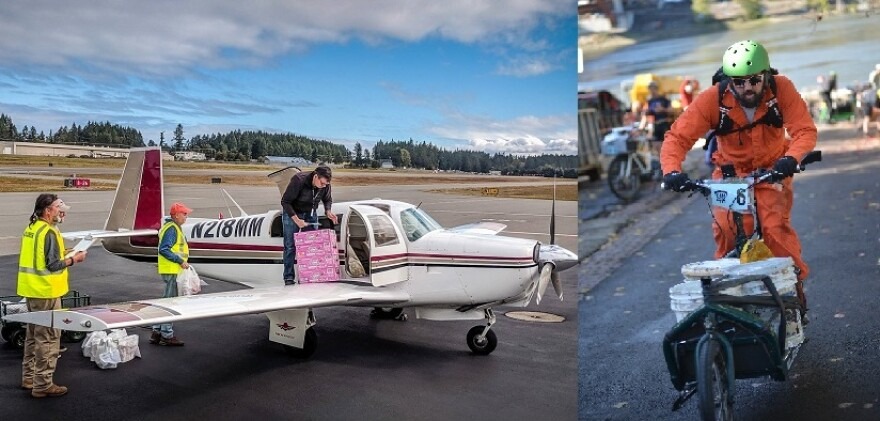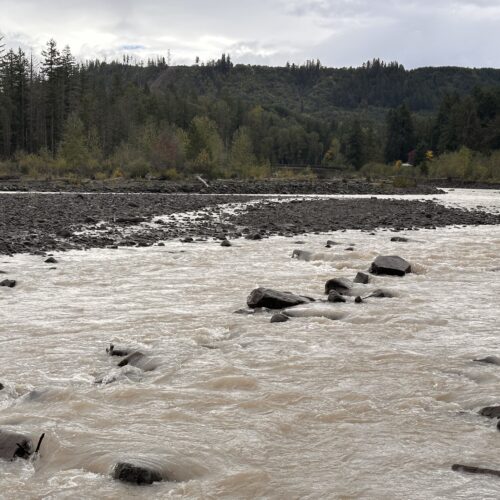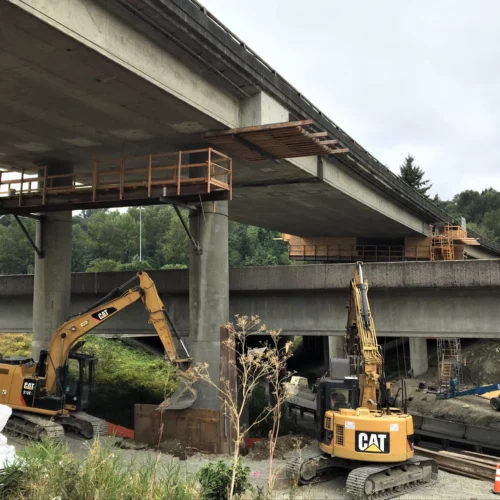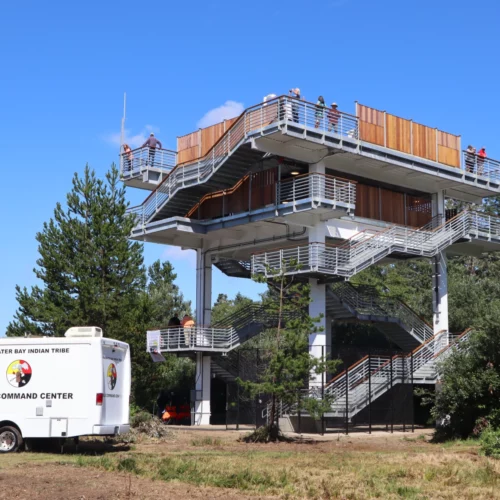
By Air And By Bike, Civilian Pilots And Cyclists Rehearse Delivering Aid After ‘The Big One’
Listen
(Runtime 4:24)
Read
A huge dress rehearsal for regional earthquake disaster relief was supposed to happen next week until the ongoing pandemic forced its cancellation. The scrubbed Cascadia Rising exercise would have involved more than 22,000 participants – chiefly U.S. soldiers, sailors and airmen as well as state, local and tribal emergency planners. Some smaller drills are going ahead this weekend and next featuring civilian volunteers who will demonstrate unusual ways aid may get to Pacific Northwest earthquake survivors.
This Saturday, June 11, around 40 to 50 cargo bike riders will compete in a disaster relief drill in Portland. The following weekend, June 18, more than 100 private pilots from Oregon, Washington and British Columbia will take to the skies to shuttle food from airfield to airfield in another mock quake relief effort.
The drill scenarios entail a magnitude 9.0 full rip of the offshore Cascadia earthquake fault from Vancouver Island to northern California – aka “The Big One.” That brings widespread devastation west of the Cascade Range in Oregon and Washington state. The highways to the east, north and south are severed.
In this worst case scenario, help will come from above said aptly named Sky Terry, the Northwest regional director of the Emergency Volunteer Air Corps. Terry likened his organization’s one-day exercise on June 18 to a “Berlin Airlift effort.”
“The other analogy would be the China-Burma hop in World War II,” Terry said in an interview. “You lose the land route. All you’ve got is air to supply everything and keep it going.”
Terry said private pilots are prepared to go into the breach, presumably alongside the National Guard when the Big One happens for real. The offshore fault last ruptured in January 1700, spawning a tsunami that reached all the way across the Pacific to Japan. Cascadia megaquakes typically happen every 250 to 800 years. That puts the present day well within the return window.
The aerial relief drill, dubbed Thunder Run, will begin with private pilots launching from Walla Walla, Washington, and Langley, British Columbia, where boxes of food are being stockpiled for distribution into Western Washington and Oregon.
“The way to look at Walla Walla is that it is the out-of-impact area hub for the general aviation response,” said Terry, who formerly served as a communications operator in the U.S. Army. “That’s the aircraft carrier that is just outside the battle zone throwing support into the fray, but planes can come back and resources come back and it still has all the normal communication to the outside world.”
But wait, won’t the destination airports such as Renton, Bellingham, Hoquiam, Shelton and Port Angeles in Washington and Aurora, Albany and Creswell in Oregon be wrecked and unusable after the Big One? Terry replied that the backbone of the private airlift will be nimble little Cessnas, Bonanzas, Mooneys and Piper planes.
“We don’t necessarily have to use an airport,” Terry said. “We can use a stretch of Highway 101 or I-5 or any long two-lane stretch of road. So, we’re not totally dependent on having all the airports survive.”
Event organizers have collected roughly 60,000 pounds of boxed food for this one-day drill. The volunteer pilots, amateur radio operators and ground crews at the destinations including from the Civil Air Patrol will hand over the cargos to food banks to simulate bringing aid to an earthquake disaster zone.
Terry said another goal is to demonstrate to state and federal authorities the capabilities of general aviation and inspire confidence. He got the attention of the Washington State Emergency Management Division, where Robert Ezelle is director.
“When our state suffers the anticipated Cascadia earthquake and tsunami, it will take every resource we have to get our communities the help they need,” Ezelle told public radio via email. “Volunteers will be a necessity, and we constantly look at how they’ll be incorporated into our response.”
Cargo bikes to the rescue, too
Separate from the aerial relief drill, bicyclists in Portland will practice how to distribute disaster relief on two wheels. Not just any two wheels — on sturdy cargo bikes, some capable of schlepping up to 200 pounds. Event co-founder Mike Cobb said cargo bikes are ideal to get airlifted supplies across the last mile to recipients in neighborhoods.
“There might be 3,000 or 5,000 cargo bikers in Portland. You can bet that a good portion of those people are going to want to help,” Cobb said. “So, we’re going to optimize a system to deploy these willing and capable cargo bikers.”
This will be the sixth edition in Portland of what is known as the Disaster Relief Trials. Previously, there were corollary bike events in Seattle, Bend and Eugene. Cobb says the drill takes the form of a friendly competition. Bicyclists must visit seven checkpoints during Saturday’s drill, pick up cargo along the way and scale obstacles meant to mimic earthquake wreckage, including a one meter high barrier.
“Preparedness doesn’t need to be dour, laborious and boring,” Cobb said. “If it is all those things, you’re going to get less citizen participation.”
Cobb explained that he and his co-organizers coordinated with the Portland Bureau of Emergency Management so that the cargo bike competition represents a realistic extension of neighborhood disaster relief plans. The bureau is helping to promote the event.
If you don’t happen to own a small airplane or a cargo bike, there are other ways to be inspired to prepare for the Big One. The start and finish line of the 2022 Disaster Relief Trials in Northeast Portland’s Cully Park will simultaneously be the scene of a resilience fair on June 11. Manzanita will host its own emergency preparedness fair on June 16. In coastal Lincoln County, Oregon, the communities of Depoe Bay, Newport and Lincoln City are also conducting disaster rehearsals heavily reliant on volunteers in the coming days.
Related Stories:

New flood management plan considers more flooding types
After about five years in the works, the Pierce County Council adopted a new Comprehensive Flood Hazard Management Plan that broadens the scope of what kinds of flooding the county will plan for – from coastal to urban flooding.
Angela Angove is the floodplain and watershed services manager with Pierce County Planning and Public Works. She said different types of flooding are top of mind for people in the county, recalling the King Tides that caused tidal flooding last December.

Some freeways may be useable following ‘the Big One’ per new modeling by UW
New modeling by the University of Washington of the impacts of a major Cascadia earthquake offers a less dire picture of the aftermath of the so-called “Big One” — specifically when it comes to highway bridges.

Coastal Washington Tribe Creates Higher Ground By Building Tsunami Tower, First Of Its Type Here
There is a new option to escape a tsunami if you’re on the southwest coast of Washington when the Big One strikes. The Shoalwater Bay Indian Tribe on Friday dedicated a 50-foot tall evacuation tower in Tokeland, Washington. Tribal leaders and the Federal Emergency Management Agency said the new tsunami refuge platform should be an example and inspiration for other vulnerable coastal communities.















